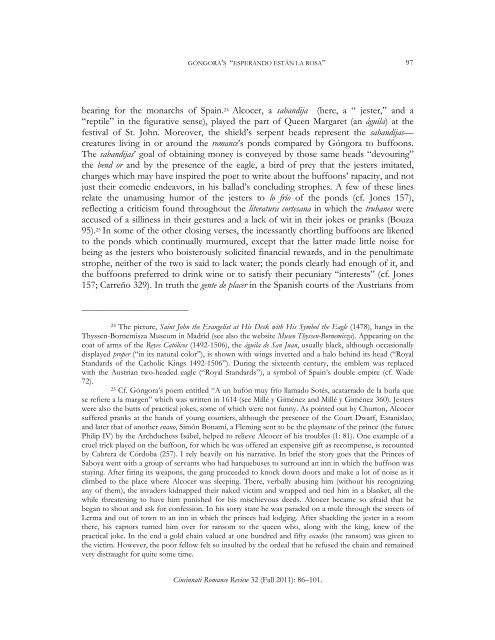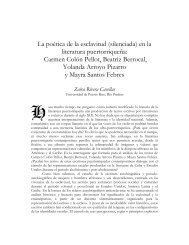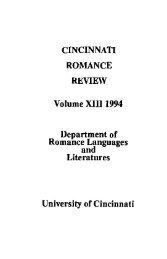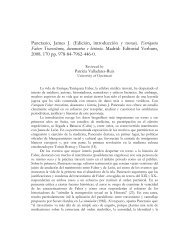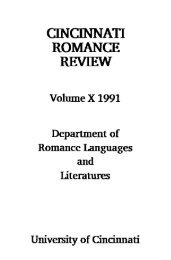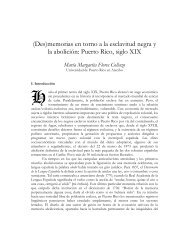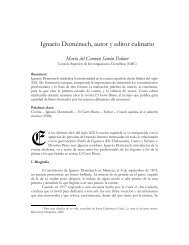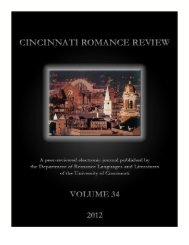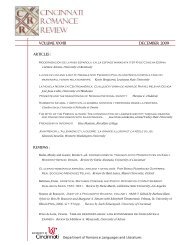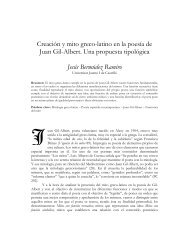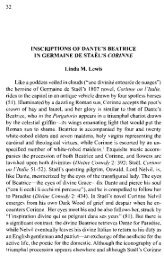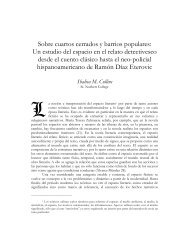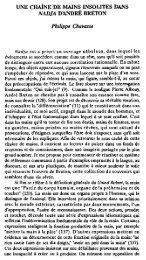96 DIANE CHAFFEE-SORACEthe fifteenth century, the buffoons distinguished themselves for their undue influence,lewdness, and dangerous witticisms, whereas by the seventeenth century, they seemed tobe tame, domesticated, and above all, numerous (Moreno Villa 24). Their cheerful oramusing aspect made their presence at court understandable, but their contemporariesheld a grudge against them, either because they were very much favored, or becausethey abused their positions of trust (Moreno Villa <strong>32</strong>-33). In general the jesters acted asmessengers and spies, influenced public opinion with their diatribes and criticisms, andplayed a useful part in service to the crown (Moreno Villa 33).According to Churton, the Court Fool of King Philip III (a man called Alcoceror Alcocerico) was possibly a Morisco whose amusing mimicry of Queen Margaretwould have been even funnier, if he had chosen to speak in broken Castilian likeAlcuzcuz in Calderón’s play Amar después de la muerte (1:80-81). Luis Cabrera de Córdobareports that, on St. John’s Eve in 1605, Alcocer assumed the role of the queen in amasque at the palace of the Ventosilla (253). Fernando Bouza summarizes Cabrera deCórdoba’s account of the dramatic entertainment:[Alcocer] representaba la parte de la reina Margarita de Austria en unamáscara “disfrazada a lo pícaro” celebrada en el palacio de la Ventosilla,y que remedaba la llegada de la embajada del Almirante de Inglaterra aValladolid para la ratificación del tratado hispano inglés ese mismoaño—el conde de Nottingham fue encarnado por el capón Sevillano, elcardenal don Bernardo de Sandoval y Rojas por un cochero y el propioduque de Lerma por uno de sus criados. (70)Bouza adds that the buffoons at court were frequently given the titles of noblemen orroyalty, probably as a joke, but one in which the least significant person would appear tobe very important (142). As indicated above, the gente de placer at times pretended to bemonarchs and other grandees, and “por un momento la sabandija fing[ió] ser el águila yesto también forma[ba] parte de su laborioso quehacer de hazmerreír de cada día”(Bouza 142).Regarding Alcocer, his name can be traced to Sancho Sánchez de Alcocer, theson of King Sancho II of Navarra (Grixalba 63). A description of the Alcocer shield,which is divided per pale, follows: the diestra half has a field argent with an eagle sable; thesiniestra half shows a field sinople with a bend or flanked by twin mullets of eight or, each endof the bend in the mouth of a serpent head gules; and the bordure gules is charged with eightsotueres or (Grixalba 63). The correspondence between the depiction on the escutcheonand what little is known about the buffoon Alcocer correlates well with the relevantverses in Góngora’s poem. For example, the eagle is both a symbol of St. John theEvangelist (Wade 73), as seen in a painting by Gabriel Maelesskircher, and a heraldic<strong>Cincinnati</strong> <strong>Romance</strong> <strong>Review</strong> <strong>32</strong> (Fall <strong>2011</strong>): 86–101.
GÓNGORA’S “ESPERANDO ESTÁN LA ROSA” 97bearing for the monarchs of Spain. 24 Alcocer, a sabandija (here, a “ jester,” and a“reptile” in the figurative sense), played the part of Queen Margaret (an águila) at thefestival of St. John. Moreover, the shield’s serpent heads represent the sabandijas—creatures living in or around the romance’s ponds compared by Góngora to buffoons.The sabandijas’ goal of obtaining money is conveyed by those same heads “devouring”the bend or and by the presence of the eagle, a bird of prey that the jesters imitated,charges which may have inspired the poet to write about the buffoons’ rapacity, and notjust their comedic endeavors, in his ballad’s concluding strophes. A few of these linesrelate the unamusing humor of the jesters to lo frío of the ponds (cf. Jones 157),reflecting a criticism found throughout the literatura cortesana in which the truhanes wereaccused of a silliness in their gestures and a lack of wit in their jokes or pranks (Bouza95). 25 In some of the other closing verses, the incessantly chortling buffoons are likenedto the ponds which continually murmured, except that the latter made little noise forbeing as the jesters who boisterously solicited financial rewards, and in the penultimatestrophe, neither of the two is said to lack water; the ponds clearly had enough of it, andthe buffoons preferred to drink wine or to satisfy their pecuniary “interests” (cf. Jones157; Carreño <strong>32</strong>9). In truth the gente de placer in the Spanish courts of the Austrians from______________________24 The picture, Saint John the Evangelist at His Desk with His Symbol the Eagle (1478), hangs in theThyssen-Bornemisza Museum in Madrid (see also the website Museo Thyssen-Bornemisza). Appearing on thecoat of arms of the Reyes Católicos (1492-1506), the águila de San Juan, usually black, although occasionallydisplayed proper (“in its natural color”), is shown with wings inverted and a halo behind its head (“RoyalStandards of the Catholic Kings 1492-1506”). During the sixteenth century, the emblem was replacedwith the Austrian two-headed eagle (“Royal Standards”), a symbol of Spain’s double empire (cf. Wade72).25 Cf. Góngora’s poem entitled “A un bufón muy frío llamado Sotés, acatarrado de la burla quese refiere a la margen” which was written in 1614 (see Millé y Giménez and Millé y Giménez 360). Jesterswere also the butts of practical jokes, some of which were not funny. As pointed out by Churton, Alcocersuffered pranks at the hands of young courtiers, although the presence of the Court Dwarf, Estanislao,and later that of another enano, Simón Bonamí, a Fleming sent to be the playmate of the prince (the futurePhilip IV) by the Archduchess Isabel, helped to relieve Alcocer of his troubles (1: 81). One example of acruel trick played on the buffoon, for which he was offered an expensive gift as recompense, is recountedby Cabrera de Córdoba (257). I rely heavily on his narrative. In brief the story goes that the Princes ofSaboya went with a group of servants who had harquebuses to surround an inn in which the buffoon wasstaying. After firing its weapons, the gang proceeded to knock down doors and make a lot of noise as itclimbed to the place where Alcocer was sleeping. There, verbally abusing him (without his recognizingany of them), the invaders kidnapped their naked victim and wrapped and tied him in a blanket, all thewhile threatening to have him punished for his mischievous deeds. Alcocer became so afraid that hebegan to shout and ask for confession. In his sorry state he was paraded on a mule through the streets ofLerma and out of town to an inn in which the princes had lodging. After shackling the jester in a roomthere, his captors turned him over for ransom to the queen who, along with the king, knew of thepractical joke. In the end a gold chain valued at one hundred and fifty escudos (the ransom) was given tothe victim. However, the poor fellow felt so insulted by the ordeal that he refused the chain and remainedvery distraught for quite some time.<strong>Cincinnati</strong> <strong>Romance</strong> <strong>Review</strong> <strong>32</strong> (Fall <strong>2011</strong>): 86–101.
- Page 1 and 2:
CINCINNATI ROMANCE REVIEWA peer-rev
- Page 4 and 5:
External readersAbraham AcostaDanie
- Page 6 and 7:
!Juan Luis Vives y Erasmo de Rotter
- Page 8 and 9:
!Mayhew, Jonathan. Apocryphal Lorca
- Page 10 and 11:
2 SHALISA M. COLLINS(Álvarez Ménd
- Page 12:
4 SHALISA M. COLLINSinvoluntary exp
- Page 15 and 16:
SOBRE CUARTOS CERRADOS Y BARRIOS PO
- Page 17 and 18:
SOBRE CUARTOS CERRADOS Y BARRIOS PO
- Page 19 and 20:
SOBRE CUARTOS CERRADOS Y BARRIOS PO
- Page 21 and 22:
Tanto de aquí como de allá: NewRe
- Page 24 and 25:
16 CARYN CONNELLYbelief that social
- Page 26 and 27:
18 CARYN CONNELLYPaso through the U
- Page 28 and 29:
20 CARYN CONNELLYpresent something
- Page 30 and 31:
22 CARYN CONNELLYprovincialism. The
- Page 32 and 33:
24 CARYN CONNELLYneatly represent t
- Page 34 and 35:
26 CARYN CONNELLYtreatment of Carli
- Page 36 and 37:
28 CARYN CONNELLYConclusionsOne of
- Page 38 and 39:
30 CARYN CONNELLYGoldbarg, Pablo.
- Page 40 and 41:
32 NICOLÁS FERNÁNDEZ-MEDINAavance
- Page 42 and 43:
34 NICOLÁS FERNÁNDEZ-MEDINAEs cla
- Page 44 and 45:
36 NICOLÁS FERNÁNDEZ-MEDINAde los
- Page 46 and 47:
38 NICOLÁS FERNÁNDEZ-MEDINAasí d
- Page 48 and 49:
40 NICOLÁS FERNÁNDEZ-MEDINAfigura
- Page 50 and 51:
42 NICOLÁS FERNÁNDEZ-MEDINAdel gr
- Page 52 and 53:
Gran Señor y rajadiablos: Sátira
- Page 56: 48 LUIS HERMOSILLAfamiliar en el es
- Page 60 and 61: 52 LUIS HERMOSILLAAferrado a los co
- Page 62 and 63: 54 LUIS HERMOSILLAVicuña Urrutia,
- Page 64 and 65: 56 PAOLA MARÍNligüística, el cua
- Page 66 and 67: 58 PAOLA MARÍNy referencias en su
- Page 68 and 69: 60 PAOLA MARÍNLa renovación que l
- Page 70 and 71: 62 PAOLA MARÍNclave en Borges, sin
- Page 72 and 73: 64 PAOLA MARÍNdel bachiller Franci
- Page 74 and 75: 66 PAOLA MARÍNdebe sobresalir. En
- Page 76 and 77: 68 PAOLA MARÍN---. “Francisco de
- Page 78 and 79: Juan Luis Vives y Erasmo de Rotterd
- Page 80 and 81: 72 OLGA RIVERAingenios y escritores
- Page 82 and 83: 74 OLGA RIVERAque reproducen en min
- Page 84 and 85: 76 OLGA RIVERAentre otros argumento
- Page 86 and 87: 78 OLGA RIVERAreaches age seven) lo
- Page 88 and 89: 80 OLGA RIVERAand hard work” (Ree
- Page 90 and 91: 82 OLGA RIVERAoccupation for the ju
- Page 92 and 93: 84 OLGA RIVERAámbito de la domesti
- Page 94 and 95: Góngora’s “Esperando están la
- Page 96 and 97: 88 DIANE CHAFFEE-SORACEWhereas the
- Page 98 and 99: 90 DIANE CHAFFEE-SORACEIn Góngora
- Page 100 and 101: 92 DIANE CHAFFEE-SORACEHowever, whe
- Page 102 and 103: 94 DIANE CHAFFEE-SORACEThe bard’s
- Page 106 and 107: 98 DIANE CHAFFEE-SORACE1563 to 1700
- Page 108 and 109: 100 DIANE CHAFFEE-SORACEGilmer, Mau
- Page 110 and 111: Maternal Agency in Lucía Etxebarri
- Page 112 and 113: 104 MARINA BETTAGLIOprocreation no
- Page 114 and 115: 106 MARINA BETTAGLIOwho rescued her
- Page 116 and 117: 108 MARINA BETTAGLIOmystical interv
- Page 118 and 119: 110 MARINA BETTAGLIOnot represent t
- Page 120 and 121: 112 MARINA BETTAGLIOproductions. Li
- Page 122 and 123: 114 MARINA BETTAGLIO“Sé que est
- Page 124 and 125: 116 MARINA BETTAGLIOtheir real-life
- Page 126 and 127: 118 MARINA BETTAGLIO---. “Acerca
- Page 128 and 129: Tu mettrais l’univers entier dans
- Page 130 and 131: 122 JEAN-FRANÇOIS DUCLOS(Battues 4
- Page 132 and 133: 124 JEAN-FRANÇOIS DUCLOSpaupière,
- Page 134 and 135: 126 JEAN-FRANÇOIS DUCLOSmaintient.
- Page 136 and 137: 128 JEAN-FRANÇOIS DUCLOSne peut qu
- Page 138 and 139: 130 JEAN-FRANÇOIS DUCLOSEt pour ce
- Page 140 and 141: 132 JEAN-FRANÇOIS DUCLOSŒUVRES CI
- Page 142 and 143: 134 REGINA L. PESZATsimplicity, Ern
- Page 144 and 145: 136 REGINA L. PESZATbourgeoises de
- Page 146 and 147: 138 REGINA L. PESZATTransfiguration
- Page 148 and 149: 140 REGINA L. PESZATthe impoverishe
- Page 150 and 151: 142 REGINA L. PESZATillusion simila
- Page 152 and 153: 144 REGINA L. PESZATOne might hypot
- Page 154 and 155:
Entre deux régimes de censure:Le c
- Page 156 and 157:
148 EDWARD OUSSELINEn France, “l
- Page 158 and 159:
150 EDWARD OUSSELINquelque sorte, p
- Page 160 and 161:
152 EDWARD OUSSELINsocialement bann
- Page 162 and 163:
154 EDWARD OUSSELINEmmanuelle (Just
- Page 164 and 165:
156 EDWARD OUSSELINUn reflet peu no
- Page 166 and 167:
158 EDWARD OUSSELINHeise, William,
- Page 168 and 169:
When Feasting with the Statue Is Du
- Page 170 and 171:
162 KATHRYN WILLIS WOLFEAu tournant
- Page 172 and 173:
164 KATHRYN WILLIS WOLFEproblematic
- Page 174 and 175:
166 KATHRYN WILLIS WOLFEformed part
- Page 176 and 177:
168 KATHRYN WILLIS WOLFEto imitate,
- Page 178 and 179:
170 KATHRYN WILLIS WOLFEthe word ca
- Page 180 and 181:
172 KATHRYN WILLIS WOLFEemerging se
- Page 182 and 183:
174 KATHRYN WILLIS WOLFEpromises, w
- Page 184 and 185:
176 REVIEWED BY PATRICIA VALLADARES
- Page 186 and 187:
Alberca, Manuel. El pacto ambiguo:
- Page 188 and 189:
180 REVIEWED BY ANDRÉS PÉREZ-SIMO
- Page 190 and 191:
Álvarez, Enrique. DENTRO/FUERA: El
- Page 192 and 193:
184 REVIEWED BY BEATRIZ CELAYA CARR
- Page 194 and 195:
ROMANCERO 179Hispanista ya había p
- Page 196 and 197:
ROMANCERO 181Aunque no ha encontrad
- Page 198 and 199:
Fisher, Andrés. Series. Poesía re
- Page 200 and 201:
192 REVIEWED BY MARÍA CLEMENCIA S
- Page 202 and 203:
194 REVIEWED BY MANUEL CERPAAunque
- Page 204 and 205:
196 REVIEWED BY MANUEL CERPAtanto d
- Page 206 and 207:
198 REVIEWED BY PEDRO P. PORBÉNent
- Page 208 and 209:
200 REVIEWED BY PEDRO P. PORBÉNEn


